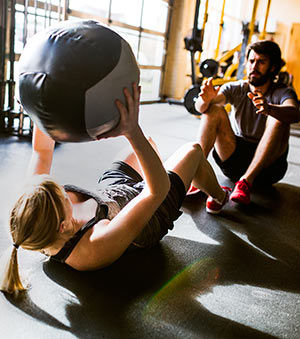
High-intensity interval training (HIIT) continues to be a popular format for fitness pros to teach in classes and with clients. However, because of its simplicity, HIIT has the potential to feel a bit stale if you don’t eventually mix it up with new exercises and work-to-rest ratios. Clients will be the first to tell you that doing jumping jacks in 30-second bursts only feels exciting for so long.
With a little creativity, however, HIIT classes and training sessions have the potential to be quite varied. Changing up exercises is an obvious place to start, but the potential for variety extends well beyond exercise selection. In fact, you can tweak just about every aspect of a HIIT session.
“There are various parameters of HIIT that can be manipulated, including number of interval bouts, length of interval bouts, intensity of interval bouts, frequency of HIIT, rest intervals and duration of rest,” explains Lance Dalleck, Ph.D., director at the Center for Wellness and Human Performance and assistant professor of exercise and sport science at Western State Colorado University. “All these parameters can be modified from week to week and month to month to keep the client exposed to a new form of HIIT.”
While any unskilled trainer can assault clients with exercises that are over-the-top challenging, educated fitness pros know that programming safe, effective HIIT requires forethought and purpose.
“Plan your workouts to make physiological sense,” says Helen Vanderburg, an award-winning fitness presenter and president of Heavens elevated fitness in Calgary, Alberta. “Vary the movement patterns and be aware of overload. The higher the intensity of work, the longer the recovery needs to be.”
Read on for expert-tested ideas and inspiration for keeping HIIT drills fresh without compromising the basic tenets of intelligent interval exercise.
ROTATE RATIOS
Ideas For Changing Up HIIT Workouts
- Length of work intervals
- Length of recovery intervals
- Number of interval sets/cycles
- Intensity/type of exercise
- Equipment used per exercise
- Applying familiar equipment in new ways (e.g., as props)
- Format (individual, partner, circuit)
- Counting reps versus timed intervals
- Intervals with more than two parts (e.g., 30/20/10)
- Using mobile apps to time intervals
- Interactive games that follow HIIT protocols
Altering interval times instantly changes the challenge and perhaps intention behind a HIIT set. “There are infinite ways you can construct intervals based on work-to-rest ratios,” says Vanderburg. “Let's use a minute as an example." You can do 30 seconds of work with 30 seconds of recovery.” So: 30 seconds/30 seconds. Within that one-minute timeframe, there’s also:
- 45 seconds/15 seconds
- 15 seconds/45 seconds
- 40 seconds/20 seconds
- 20 seconds/40 seconds
“It’s endless,” says Vanderburg. Further, you can adjust the number of sets; for example, three cycles of 45 seconds on and 15 seconds off, or 30 second/30 second intervals done six times total.
Of course, you’re not limited to intervals that add up to one minute or even interval pairs. Why not play around with a three-part ratio? Irene Lewis-McCormick, M.S., author of The HIIT Advantage for Women (Human Kinetics, 2015), includes the following work-to-rest ratios in her interval workouts: three minutes/90 seconds, 30/20/10, 40/30/20 and 20/10. Based in Iowa, Lewis-McCormick is an adjunct faculty member at Simpson College and Fitness Education Director for Octane Fitness.
Using mobile apps such as Tabata Pro, Runtastic Timer or Fitness Intervals by TRUE can help you pre-plan HIIT drills and easily track them during a workout. With its timer pre-set to 30/20/10, the free JogRunSprint app allows for HIIT training in a three-part ratio.
COUNT REPS
Another approach is to abandon your interval timer altogether and structure a HIIT set around reps. Vanderburg sometimes uses this technique in place of timed formats. “Rather than using the Tabata time of 20:10, which can become boring,” she says, “go for 15 repetitions of a hard lower-body exercise followed by five repetitions of a recovery exercise. Cycle through that 10 times.” She recommends taking an adequate recovery and then repeating those same work/recovery reps again, but with a challenging upper-body exercise.
Lewis-McCormick also uses rep-based intervals in her small-group training sessions. First, clients find partners. “One person does an exercise for a certain number of reps, while the other one works at an assigned skill for as long as her partner takes to do the reps,” she says. For example, one person might do jump squats with quarter-turns while the other person performs a forearm plank. “I usually ask people to do reps based on the complexity and intensity of the exercise,” explains Lewis-McCormick. “So 10 to 12 reps of jump squats with quarter-turns will likely require a 30- to 40-second forearm plank.” When the rep-counter reaches his or her assigned number of reps, the partners take a short breather before switching exercises.
CREATE CIRCUITS AND PARTNER DRILLS

If you’ve got the floor space in your small-group training or fitness class, consider turning HIIT cycles into social circuits. “My clients fondly know this part of my classes as DRILL,” says Crystal Reia, a personal trainer and owner of Your Health—Your Choice in Kitchener, Ontario, Canada. “Sometimes I create fun, out-of-the-box stations around the room and send my participants around in couples or small groups.” One of Reia’s favorite set-ups involves a 30-second interval with a 15-second recovery. Before moving on to the next station, however, participants repeat another 30-second interval at that same station. “They basically get a minute’s worth of work per station, before trying the next one,” she says. Each circuit consists of about five or six stations, and the entire circuit lasts about 10 to 12 minutes. “After they get through the entire five or six stations, we break for a couple of minutes for water,” says Reia. “Then we usually go one more round.”
Circuit or no circuit, you can still take advantage of the variety that camaraderie provides. “Partner and small-group challenges work really well to break up monotony and make HIIT classes interactive,” says Vanderburg. “In partner training, [participants] can ‘share the work.’ For example, the goal might be to complete 100 air squats, 100 kettlebell swings and 100 full sit-ups. Partners can strategize however they would like to complete the task by sharing the work. For example, Partner 1 does 20 squats, and then Partner 2 does 20 squats. Or Partner 1 goes to fatigue, and then Partner 2 takes over and goes to fatigue. They continue switching back and forth until the goal is met.”
SWITCH UP EQUIPMENT
If clients are used to doing certain HIIT drills with standard equipment like dumbbells, you could you teach them the same or similar moves using a medicine ball instead. There’s also the option to employ equipment as “props.” For example, ask clients or participants to configure a resistance band or jump rope on the floor, allowing for high-intensity footwork in a new way (think agility ladder, but modified). Even painter’s tape or chalk-drawn lines (for outdoors) would work.
“Simply changing the equipment you are using can give the same exercise an entirely different edge while still keeping it familiar for participants,” says Caroline Fleming, a group fitness instructor in Kirkland, Wash., where she teaches a weekly HITT class in addition to incorporating HIIT drills into her other classes.
“To keep HIIT fresh yet still familiar,” explains Fleming, “I will take an exercise we are comfortable with (e.g., squat jumps or toe taps) and use an additional piece of equipment. For example, instead of only using the floor, we can do squat jumps holding a stability ball overhead. Toe taps can be done around a step360 or BOSU ball. Little changes can make a big difference.” But stick with simplicity. “I feel that if the exercise gets too complicated, participants are unable to increase intensity as much as they might like,” says Fleming.
Using everything from mini trampolines and suspension trainers to dumbbells and kettlebells, Lewis-McCormick frequently adapts the same exercise to different pieces of equipment. “I will perform a lunge using gliding disks; then I will do that same exercise (foundationally, it is the same movement with similar movement standards and expectations), but I will use the suspension trainer. Then I can try that same lunge using the dumbbells or a kettlebell or a medicine ball. This way the same foundational cues are in play, but we are just changing it up with different equipment.”
However, she rolls out equipment modifications gradually. “I don’t typically make all these changes in each class session,” says Lewis-McCormick. “I will use that one piece of equipment for that one small-group class session, then next time, I will change the equipment. Otherwise, it gets confusing and diluted and the movement standards get fuzzy. But participants remember the foundational cues and that makes it really fun and challenging and different, but consistent.”
While Dalleck agrees that swapping out equipment can help keep HIIT routines fresh, he adds this important caveat: “Fitness professionals should first teach clients the requisite skill for the exercise or piece of equipment being incorporated into HIIT. The rationale is that if clients are performing HIIT using kettlebells, and are unfamiliar with proper technique, they are at an increased risk of injury because of the high-intensity nature of HIIT,” he says.
REAP THE REWARDS OF RECOVERY
High-intensity intervals tend to be the main attraction in HIIT, but you can also add variety by making small modifications to active recovery. For example, Fleming teaches a “plank and power” section of her class involving 30 seconds of high-intensity cardio paired with 30 seconds of a plank exercise. “I feel that alternating HIIT cardio work (which is usually fairly simple so that participants can perform it correctly) with a more complex but less intense strength move keeps everyone interested, yet still able to push themselves,” says Fleming.
With brainstorming and preparation, you can add thrilling variations to your HIIT classes or training sessions right away. But it’s possible to overload on too much of a good thing—remember that clients shouldn’t be doing HIIT every day.
“In general, I would suggest HIIT no more than two days per week, interspersed with at least 24 hours of rest or a lower-intensity day,” says Dalleck. You might even suggest clients take a break from HIIT periodically. “Every month it would be beneficial to have a week of training that did not consist of HIIT,” suggests Dalleck. “This permits sufficient training recovery.”
In fact, why not leverage these breaks as a defense against boredom? An appropriate absence from HIIT might just make the heart grow fonder.





 by
by 



